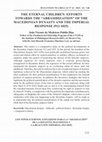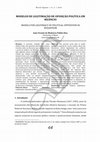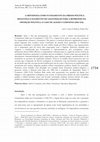Books by João Vicente de Medeiros Publio Dias
Languages of Power and Authority in Byzantium and Beyond, 2024
Languages of Power and Authority in Byzantium and Beyond, 2024
This volume is the first in a series of publications prepared by the Young Academics Network
Byza... more This volume is the first in a series of publications prepared by the Young Academics Network
Byzantium Mainz / Frankfurt. These small volumes reflect the discussions conducted in one of our »round tables«, a format that we established in 2019 to bring together young scholars
in Byzantine Studies in order to share their work and to discuss current topics of research in
our disciplines. On the basis of the presented papers, the round tables provide a space for
intense exchange between the researchers and offer the possibility to jointly develop new
thoughts and perspectives of research.
Papers by João Vicente de Medeiros Publio Dias

Antíteses, 2024
[ENGLISH BELOW]
Aleixo I Comneno (1081-1118) é conhecido pela historiografia por ter estabelecid... more [ENGLISH BELOW]
Aleixo I Comneno (1081-1118) é conhecido pela historiografia por ter estabelecido um governo familiar no qual seus parentes não apenas recebiam privilégios extraordinários, mas também um papel mais importante no governo do que o dos familiares dos imperadores anteriores. Ninguém personificou mais essa inovação do que seu irmão, Isaac Comneno (1050-1102/1104). Ele foi nomeado por Aleixo sebastokrator, que é uma associação entre dois títulos originalmente imperiais: autokrator (lat. imperator) e sebastos (lat. augustus). Isso simbolizava o status como quase igual ao imperador que Isaac desfrutou durante o reinado de seu irmão. Nessas inovações criadas por Aleixo eram quase sem precedentes, exigindo adaptações ou até mesmo invenções linguísticas por parte dos retóricos que exaltavam os membros da aristocracia dos Comnenos e dos historiadores que tentavam esclarecer as políticas de Aleixo. Assim, o presente artigo analisará algumas fontes escritas, como obras historiográficas, retóricas e epigráficas, e pictóricas, como selos de chumbo e mosaicos decorativos, relacionadas a Isaac, a fim de entender como a linguagem de diversos gêneros foi adaptada para construir a autoridade e poder extraordinário do irmão do imperador e as relações entre os dois.
Alexios I Komnenos (1081-1118) is known by the historiography for having established a family government in which his relatives not only received extraordinary privileges, but also a more important role in government than the relatives of previous emperors. No one personified this innovation more than his brother, Isaac Komnenos (1050-1102/1104). He was bestowed by his brother with the title sebastokrator, which is an association between two originally imperial titles: autokrator (lat. imperator) and sebastos (lat. augustus). This represented the status as almost equal to the emperor that Isaac enjoyed during his brother’s reign. However, these innovations created by Alexios were almost unprecedented, requiring linguistic adaptations or even inventions on the part of rhetoricians who praised the members of the Komnenian aristocracy and the historians who tried to clarify Alexios’ policies. Thus, this article will analyse some written sources, such as historiographical, rhetorical, and epigraphic works, and pictorial sources, such as lead seals and decorative mosaics, related to Isaac, in order to understand how the language of various genres was adapted to construct the authority and extraordinary power of the emperor's brother and the relationships between the two.

Medievalista, 2024
[PORTUGUÊS]
A rebelião que levou os Comnenos ao poder, em 1081, foi bem-sucedida e resultante d... more [PORTUGUÊS]
A rebelião que levou os Comnenos ao poder, em 1081, foi bem-sucedida e resultante de vários apoios, o mais importante dos quais foi dado pelos Ducas, uma linhagem que já havia controlado o poder imperial e com a qual Aleixo era ligado por matrimônio. A posição tradicional da historiografia é de que esse foi o início de um governo aristocrático no qual os parentes do imperador desfrutavam de uma parcela do poder. Entretanto, estudos mais recentes contestam a extensão da distribuição de poder sob os Comnenos (1081-1118), alegando que esses imperadores eram mais centralizadores e tradicionais do que se pensava anteriormente. No entanto, de fato, os imperadores distribuíram o poder, principalmente Aleixo I (1081-1118), mas de forma mais restrita e pontual. Assim, em função do papel dos Ducas na rebelião, esperava-se que Aleixo I compartilhasse o poder com essa família, mas preferiu fazê-lo com sua mãe e seu irmão. Os Ducas, sentindo-se melindrados, não pouparam esforços para buscar espaço no regime, resultando em uma série de crises internas que contrapuseram diversos membros desse consorcio familiar que havia tomado o poder. Por fim, não foram bem-sucedidos. Contudo, essa reivindicação por poder partilhado produziu uma identidade paralela dos Ducas e discursos correspondentes, os quais perduraram após a morte de Aleixo I e continuaram existindo durante o reinado de João II (1118-1143). Esta identidade enfatizava o papel desta família na tomada do poder e na legitimação do novo imperador, assim como demandava espaço e poder. Este artigo tratará destes temas.
[ENGLISH]
The rebellion that brought the Komnenoi to power in 1081 was successful because it had many supporters, the most important of which was the Doukai, a lineage that had already controlled imperial power and with which Alexios was linked by marriage. The traditional position of historiography is that this was the beginning of an aristocratic government in which the emperor’s relatives enjoyed a share of power. However, more recent studies dispute the extent of the distribution of power under the Komnenoi (1081-1118), claiming that these emperors were more centralizing and traditional than previously thought. However, in fact, the emperors did distribute power, especially Alexios I (1081-1118), but in a more restricted and ad hoc way. Thus, given the Doukas’ role in the rebellion, it was expected that Alexios I would share power with this family, but he preferred to do so with his mother and brother. The Doukas, feeling aggrieved, spared no effort to gain a foothold in the regime, resulting in a series of internal crises that pitted various members of the family consortium that had seized power against each other. In the end, they were unsuccessful. However, this claim for shared power produced a parallel identity for the Doukas and corresponding discourses, which lasted after the death of Alexios I and continued to exist during the reign of John II (1118-1143). This identity emphasized the role of this family in seizure of power and the legitimization of the new emperor, as well as demanded space and power. This article will deal with these issues.

Byzantion Nea Hellás 42, 2023
This article is a comparative study on the political developments in the Byzantine Empire between... more This article is a comparative study on the political developments in the Byzantine Empire between 912 and 1025. In this period, the members of the Macedonian dynasty (867-1056) were politically neutralized because power was seized and shared either by eunuch-ministers or military officers, acclaimed co-emperors under the pretext of protecting the interest of the dynastic emperors. Although regencies for minor emperors were a recurrent power-sharing arrangement in Byzantine history, the regencies of this period differed, for they maintained the dynastic emperor in an everlasting status of minor until late adulthood. Therefore, this article analyses the so far exceptional degree of dynastic legitimacy achieved by the Macedonian emperors, which ended up creating the ideal conditions for their political neutralization. It also emphasizes the unusual position of emperor-protector. In addition, the discursive strategies that tried to legitimate the political neutralization of the dynastic emperors and the movements made by the political actors of the time to enforce it were analysed, along with how Basil II (976-1025) finally put an end to it by emancipating himself from the extended minority forced upon him, reinforcing his right as emperor to rule by himself. Finally, a comparison with the political developments simultaneously taking place in Baghdad, the centre of the Abbasid Caliphate, which share several similarities with what was happening in the Byzantine Empire, will be made as to understand why the political neutralization of the caliph was finally achieved while that of the Byzantine emperor failed.
Journal of Late Antique, Islamic and Byzantine Studies , 2023
This article is a study on projects of jurisdictional division of imperial territory from the ten... more This article is a study on projects of jurisdictional division of imperial territory from the tenth to the twelfth century. For that, modern concepts of “power-sharing” and “power settlement” will be adapted for the analysed context. Initially the history of territorial power-sharing in the Roman Empire will be summarised to underline the long tradition upon which the studied projects lay. Then the political strategies behind those projects are also analysed, as well as how sources present them.

Circulações, guerras, discursos e religiosidades nas fronteiras da cristandade, 2023
A história de Bizâncio é concebida tradicionalmente de forma instrumental, ou seja, o Império Biz... more A história de Bizâncio é concebida tradicionalmente de forma instrumental, ou seja, o Império Bizantino tinha um papel de contribuinte eventual para a história mundial, que é um relato linear da história do mundo ocidental. Uma dessas concepções é de Bizâncio como baluarte do Cristianismo contra o Islamismo. Essa visão simplista e funcional é equivocada, pois a relação entre Bizâncio e Islã não pode ser resumida ao conflito ininterrupto. Ela foi muito mais complexa e multifacetada. Dessa forma, esse capítulo analisa um dos aspectos dessa interação: as relações transfronteiriças entre elites num período entre a metade do século IX e as primeiras décadas do XI. Para tal, será feito um estudo comparativo: a literatura épica bizantina servirá de ponto de partida para analisar como a relação transfronteiriça entre elites se dava. Assim, esse gênero será comparado com outros tipos de fontes, assim como como estudos realizados sobre o contexto histórico fronteiriço. Isso permite que estudemos não somente a relação entre diversas elites presentes na fronteira, mas entre elas e os agentes estatais.
Para além do Ocidente cristão: outras Idades Médias?, 2023
Livro publicado em In: Uchoa Borgongino, Bruno (ed.). Para além do Ocidente cristão: outras Idade... more Livro publicado em In: Uchoa Borgongino, Bruno (ed.). Para além do Ocidente cristão: outras Idades Médias? Recife: Editora UFPE, 2023, p. 186-208
Liberté de parole. Islam, Byzance, Occident (VIIIe-XIIIe siècle). Les élites religieuses et la critique du pouvoi, 2023
published in: Abbeès, Makram/ Seénellart, Michel/ Charansonnet, Alexis/ Isaiah, Marie-Celine (ed.... more published in: Abbeès, Makram/ Seénellart, Michel/ Charansonnet, Alexis/ Isaiah, Marie-Celine (ed.). Liberté de parole. Islam, Byzance, Occident (VIIIe-XIIIe siècle). Les élites religieuses et la critique du pouvoir, Brepols, 2023, pp. 243-264.

Byzantinische Zeitschrift, 2022
In this article, we analyse two basilikoi logoi by Theophylact of Ohrid addressed to the emperors... more In this article, we analyse two basilikoi logoi by Theophylact of Ohrid addressed to the emperors Constantine Doukas (1081-1091?) and Alexios I Komnenos (1081-1118) and contest recent scholarship which traces criticism to Alexios I by the use of subversion of traditional rhetorical topoi. We do not question the presence of such subversions, but rather their function in the text. For that, they are studied in their performative contexts: ceremonial events, performative practices and the political circumstances in which their composition possibly took place and when they were performed. By doing so, it is noticeable that criticism to the emperor in such situations is hardly conceivable and the inadequacies of the praises present in the texts can be interpreted as a response to already existing criticism to current imperial policy. Moreover, by comparing both orations as autonomous works, it is possible to perceive a clear shift both in the power balances in the recently established Komnenian consortium and in the relationship between Theophylact and major political player of his time.
VIANNA, Luciano José (ed.), A História Medieval entre a formação de professores e o ensino na Educação Básica no século XXI: experiências nacionais e internacionais. Rio de Janeiro, RJ: Autografia, 2021., 2021
Publicado em VIANNA, Luciano José (ed.), A História Medieval entre a formação de professores e o ... more Publicado em VIANNA, Luciano José (ed.), A História Medieval entre a formação de professores e o ensino na Educação Básica no século XXI: experiências nacionais e internacionais. Rio de Janeiro, RJ: Autografia, 2021.
Dicionário: Cem Fragmentos Biográficos: A Idade Média em Trajetórias, 2020
In: NASCIMENTO, Renata Cristina de Sousa & SOUZA, Guilherme Queiroz de (orgs.). Dicionário: Cem F... more In: NASCIMENTO, Renata Cristina de Sousa & SOUZA, Guilherme Queiroz de (orgs.). Dicionário: Cem Fragmentos Biográficos: A Idade Média em Trajetórias. Goiânia: Editora Tempestiva, 2020, p. 257-262.

Signum, 2020
Resumo: O presente trabalho tem como objetivo lidar com questões abertas por estudos recentes sob... more Resumo: O presente trabalho tem como objetivo lidar com questões abertas por estudos recentes sobre os discursos que normatizavam o processo político em Bizâncio. Analisaremos aqui algumas dessas tradições discursivas e a relação que tinham umas com as outras; da mesma forma será examinado como elas eram usadas para legitimar a prática de oposição em Bizâncio entre os séculos XI e XIII. O artigo apresenta, desse modo, estudos de caso baseados em fontes historiográficas e examina as diversas formas de construção de discursos que justificavam a deposição de imperadores e como esses discursos se relacionam com o Ideia Imperial (Kaiseridee), que elevava o cargo imperial a uma posição sacrossanta. É demonstrado como os autores bizantinos criavam soluções coerentes, idiossincráticas e criativas para adequar seus relatos sobre manifestações de oposição a imperadores, como rebeliões e conspirações, à multiplicidade de discursos e ideologias disponíveis.
Abstract: The present work aims to tackle questions opened by recent studies about the discourses which legitimized the political process in Byzantium. We analyze here some of the discursive traditions, as well as how they related to each other; similarly, it will be examined how they were used to legitimize the practice of opposition in Byzantium between the 11 th and 13 th centuries. The article presents, therefore, case studies based in historiographic sources and examines the several forms of discourse construction that justify the deposition of emperors, and how these discourses relate with the Imperial Idea (Kaiseridee), which elevated the imperial office to a divine level. It presents how Byzantine authors created coherent, idiosyncratic and creative solutions to adapt their reports about manifestations of opposition to emperors, as rebellions and conspiracies, to the multiplicity of discourses and ideologies available.

Sociedad, cultura y religión en la plena Edad Media : siglos IX al XIII, 2019
in: Sociedad, cultura y religión en la plena Edad Media : siglos IX al XIII, editado por Victoria... more in: Sociedad, cultura y religión en la plena Edad Media : siglos IX al XIII, editado por Victoria Casamiquela Gerhold ; Andrea Vanina Neyra.- 1a ed . - Ciudad Autónoma de Buenos Aires : IMHICIHU - Instituto Multidisciplinario de Historia y Ciencias Humanas, 2019.
Resumo:
O objetivo desse artigo é analisar como o poder imperial bizantino reagia a tentativas de usurpação de prerrogativas do imperador, sejam, essas tentativas, ações pontuais de insubordinação por representantes do governo imperial nas províncias, sejam tentativas de deposição do imperador, entre os anos de 1025 e 1118. Primeiramente serão abordadas as leis relacionadas a rebeliões e tentativas de usurpação, ações compreendidas pela legislação bizantina como crimes de alta traição (latim: crimen laesae majestatis/grego: kathosīosis).. Desse modo, partiremos da legislação para os episódios narrados pela historiografia e outros gêneros para entender qual papel tinha a legislação na repressão a tentativas de usurpação se elas de fato tiveram algum papel e quais fatores determinavam a ação imperial. Este artigo será dividido conforme os três passos tradicionais relacionados à repressão imperial – o processo, a pena e a clemência – na medida em que as fontes permitirem. Será examinado o contexto no qual elas aparecem e não aparecem, e também a razão da enorme variedade de reações imperiais.
Palavras-chave: Repressão Política, Lesa Majestade, Império Bizantino, História Política, Século XI
Abstract:
The aim of this article is to analyze how the Byzantine imperial power reacted to attempts of usurpation of imperial prerogatives, either local insubordinations by representatives of the imperial government, or attempts to depose the emperor, between the years of 1025 and 1118. Firstly, the Byzantine laws concerning rebellions and usurpation attempts will be approached, the Byzantine legislation characterizes those actions as high treason (Latin: crimen laesae majestatis/Greek: kathosīosis). Accordingly, the analysis will begin with the legislation and then go to the episodes reported by the historiography and other literary genres in order to understand which role the legislation had in the repression of usurpation attempts – if it had one at all – and which factors determined imperial action. This article will be divided according to the three traditional steps related to the imperial repression – the proceedings, the punishment and mercy – in so far as the sources allow it. The context in which they appear and in which they do not will be analyzed, as well as the great variety of imperial reactions.
Key-words: Political Repression, High Treason, Byzantine Empire, Political History, 11th Century.

Der Herrscher als Versager?! Vergleichende Perspektiven auf vormoderne Herrschaftsformen, 2019
in: H. Grieser/H. Frielinghaus/S. Graetz/L. Körntgen/J. Pahlitzsch/D. Prechel, Der Herrscher als... more in: H. Grieser/H. Frielinghaus/S. Graetz/L. Körntgen/J. Pahlitzsch/D. Prechel, Der Herrscher als Versager?! Göttingen: V&R Unipress, 2019 (Kraftprobe Herrschaft Band 1), pp. 297-320
Zusammenfassung
In diesem Aufsatz wird die Entstehung der Darstellung des byzantinischen Kaisers Nikephoros III. (reg. 1078-1081) als gescheiterten Kaisers schlechthin durch die byzantinischen Historiographen analysisiert und die diesem Bild zugrunde liegenden politischen Interessen identifiziert, die kritiklos durch die moderne Historiographie übernommen wurde. Es wird hier gefolgert, dass die Darstellung des Nikephoros und seiner Herrschaft durch die Geschichtsschreibung vor allem dem Bedarf der neuen Dynastie der Komnenoi (1081-1185) entsprach, durch die er abgelöst wurde. Die Komnenoi präsentierten sich als Erneuer des Römischen Reiches, als neue Konstantine. Die Regierung des Nikephoros III. sei infolgedessen zum Symbol des Verfalls und von allem, was in Byzanz falsch gelaufen sei, geworden.
Summary:
The present chapter analyses the emergence of the portrayal of the Byzantine emperor Nikephoros III (1078-1081) as the epitome of the failed ruler by the Byzantine history-writing and identifies the political interests underlying this characterization, which was adopted by the modern historiography without proper criticism. The conclusions were that the portrayal of Nikephoros and his rule by the history-writing corresponded above all the needs of the new dynasty of the Komnenoi (1081-1185), which replaced this emperor. The Komnenoi presented themselves as being those that renewed the Roman Empire, as New Constantines. The rule of Nikephoros III became, accordingly, a symbol of decay and of everything that went wrong in Byzantium.

In: Ampoutis, A. et al. (ed.): Violence and Politics. Ideologies, Identities, Representations, Cambridge Scholars 2018, 2018
The rise to power of the Komnenoi in April 1081 was marked by the use of great violence. Constant... more The rise to power of the Komnenoi in April 1081 was marked by the use of great violence. Constantinople was ransacked by Alexios Kommenos’ troops, senators were attacked and even religious buildings were not spared. Albeit the Byzantine political history in the 11th Century was full of civil wars and violent coups-d’état, the rebels, successful and unsuccessful alike, held the will of the inhabitants of the capital respectfully. They normally did not use to force themselves into the city, but made efforts to win its favor. Sometimes violence was used to pressure acceptance, often unsuccessfully, but none of them tried to take Constantinople by force until Alexios Komnenos. It reflected the role of legitimacy givers that the city’s inhabitants and its institutions achieved during that century. However, Alexios Komnenos made no effort whatsoever to gain the favor of the city’s people or its elite, the Senate, but conquered it as he were an invader. This act had a strong symbolical meaning and many consequences. For its violence and disregard for the will and role of the senatorial elite and the groups linked to the market that gained influence in the last decades, his seizure of power caused a great deal of critic, which only partially came to us because of the mostly pro-Komnenian character of the sources and the climate of political repression that Alexios I Komnenos established as emperor. Nonetheless, it is possible to read in the sources a set of measures taken by the emperor and his inner circle of relatives to, at the same time, appease the dissatisfaction of the inhabitants of Constantinople with his regime and to repress some expressions of opposition to it. Accordingly, the aim of this communication is to list some of those measures and understand them in the context of the political aims of the emperor Alexios.

Anais do XIV Simpósio Nacional da ABHR, Juiz de Fora, MG, 15 a 17 de abril de 2015, 2015
Resumo: Após o fim das perseguições aos cristãos e com o aberto favorecimento ao Cristianismo dad... more Resumo: Após o fim das perseguições aos cristãos e com o aberto favorecimento ao Cristianismo dado por Constantino I (324-337), a Igreja ficou cada vez mais sob a proteção dos imperadores romanos e bizantinos. Ela passou a construir discursos legitimadores para o poder imperial. Isso resultou numa construção de mundo bem particular: os bizantinos passaram a defender a existência de uma ordem criada por Deus (τάξεις), cujo representante era o imperador, pois ele havia sido empossado com o Império (βασιλεία) fundado por Augusto e cristianizado por Constantino I. Apresentando-se, por conseguinte, como defensores dessa Ordem Divina, os imperadores tomaram para si o papel de tutores morais da sociedade bizantina e passaram a combater desvios teológicos. Vemos então que esse papel foi abertamente instrumentalizado pelos imperadores para reprimir grupos oposicionistas ou de resistência ao governo do imperador reinante. Nota-se na análise desses processos que era comum que a repressão de desvios teológicos se misturasse com movimentos oposicionistas de tal modo que não era mais possível diferenciar um do outro. Obvervava-se, igualmente, que resistências por razões religiosas podiam refletir insatisfações políticas dentro da sociedade. Portanto, nesse trabalho será abordado um exemplo desse fenômeno político-religioso: o processo contra o filósofo João Ítalo em 1082 sob a condução do imperador Aleixo I Comneno (1081-1118). Embora Ítalo tenha sido processado nos quadros da Igreja, por clérigos e sob argumentos teológicos, esse evento se desenvolveu dentro de uma conjuntura política e militar bastante tensa: sob invasão normanda, embates internos dentro do grupo político governante e tensões latentes entre o imperador e a elite de Constantinopla.
Os Estudos Bizantinos no Brasil estão em sua fase inicial, logo levamos em consideração que seria... more Os Estudos Bizantinos no Brasil estão em sua fase inicial, logo levamos em consideração que seria significativo, para seu desenvolvimento, a divulgação de traduções de fontes e documentos históricos. Logo, nesse trabalho encontra-se publicadas as traduções de dois relatos, um do historiador Miguel Pselo e outro do igualmente historiador Miguel Ataliates, sobre a Batalha de Manzikert, na qual forças bizantinas e turco-sedjulcidas se encontraram nas fronteiras orientais do Império Bizantino no ano de 1071, resultando numa vitória turca. Essa batalha teve consequências que foram além dos aspectos militares, por isso os relatos sobre elas são politicamente carregados. As traduções são, então, acompanhadas de uma introdução na qual a conjuntura pré- e pós-Manzikert é analisada, assim como as posições e as alianças políticas de cada um dos autores.

¿Qué implica ser medievalista? Prácticas y reflexiones en torno al oficio del historiador (Volume 1), 2013
Miguel Psello foi um polímata e sua obra, como ele gostava de afirmar, 2 "multiforme" 3 (pantodap... more Miguel Psello foi um polímata e sua obra, como ele gostava de afirmar, 2 "multiforme" 3 (pantodapos). Da filosofia neoplatônica à hagiografia, da teologia aos oráculos caldeus, das ciências naturais à história e da teoria à prática aparentemente não havia tema ou assunto que não interessasse a Psello. Além de um intelectual eclético, ele foi uma das figuras públicas mais eminentes de seu tempo, conseguindo achar o seu nicho ou mesmo se tornando favorito de diversos imperadores que reinaram ao longo do seu período de vida. 4 Kaldelis o chama de fundador do helenismo bizantino. 5 Não chegamos a tanto, mas com certeza Psello inaugurou uma nova forma de abordagem do legado clássico pelos bizantinos. Ele defendia um retorno à análise científica do funcionamento do universo iniciada pelos gregos. De forma muito semelhante aos escolásticos que trabalhavam ao mesmo tempo nas nascentes universidades européias, Psello defendia que Deus havia criado o Universo, porém a vontade divina não estava presente em todos os fênomenos naturais. Ao criar o Universo, Deus teria estabelecido regras universais para o funcionamento de quase toda Criação, regras essas que poderiam ser conhecidas por qualquer um através da observação. Psello defendia que os gregos, sem conhecer a Deus, conseguiram chegar muito perto de conhecer essa mecânica do cosmos. Do mesmo modo, se os filósofos cristãos quisessem, conseguiriam ter esse conhecimento se adotassem esse pressuposto. Essas idéias o fizeram entrar em confronto com o establishment intelectual bizantino, profundamente ortodoxa em seu Cristianismo, que era fortemente influenciado pela corrente mística de
The arrival of the Komnenos-Doukas faction at the imperial throne, with the rising of Alexius Kom... more The arrival of the Komnenos-Doukas faction at the imperial throne, with the rising of Alexius Komnenos in 1081, represents a strong change in the rhetoric and sharing of power in Byzantium. However, while the propaganda works of this emperor’s son and grandson are well known, the literary circles related to Alexius I himself are almost unknown. Therefore, in this article, we propose that the Song of Digenis Akritas was a literary construction to legitimate the supremacy claims of Alexius I Komnenos related with Anatolia, which was menaced by the Turks and the Crusaders. We base our hypothesis on three buildings, both material and discursive: the Blachernae Palace in Constantinople, the Treaty imposed by Alexius I to the Seljuk
sultan Malik-Shah in 1116 and the Digenis’ palace by the Euphrates’ banks.











Uploads
Books by João Vicente de Medeiros Publio Dias
Byzantium Mainz / Frankfurt. These small volumes reflect the discussions conducted in one of our »round tables«, a format that we established in 2019 to bring together young scholars
in Byzantine Studies in order to share their work and to discuss current topics of research in
our disciplines. On the basis of the presented papers, the round tables provide a space for
intense exchange between the researchers and offer the possibility to jointly develop new
thoughts and perspectives of research.
Papers by João Vicente de Medeiros Publio Dias
Aleixo I Comneno (1081-1118) é conhecido pela historiografia por ter estabelecido um governo familiar no qual seus parentes não apenas recebiam privilégios extraordinários, mas também um papel mais importante no governo do que o dos familiares dos imperadores anteriores. Ninguém personificou mais essa inovação do que seu irmão, Isaac Comneno (1050-1102/1104). Ele foi nomeado por Aleixo sebastokrator, que é uma associação entre dois títulos originalmente imperiais: autokrator (lat. imperator) e sebastos (lat. augustus). Isso simbolizava o status como quase igual ao imperador que Isaac desfrutou durante o reinado de seu irmão. Nessas inovações criadas por Aleixo eram quase sem precedentes, exigindo adaptações ou até mesmo invenções linguísticas por parte dos retóricos que exaltavam os membros da aristocracia dos Comnenos e dos historiadores que tentavam esclarecer as políticas de Aleixo. Assim, o presente artigo analisará algumas fontes escritas, como obras historiográficas, retóricas e epigráficas, e pictóricas, como selos de chumbo e mosaicos decorativos, relacionadas a Isaac, a fim de entender como a linguagem de diversos gêneros foi adaptada para construir a autoridade e poder extraordinário do irmão do imperador e as relações entre os dois.
Alexios I Komnenos (1081-1118) is known by the historiography for having established a family government in which his relatives not only received extraordinary privileges, but also a more important role in government than the relatives of previous emperors. No one personified this innovation more than his brother, Isaac Komnenos (1050-1102/1104). He was bestowed by his brother with the title sebastokrator, which is an association between two originally imperial titles: autokrator (lat. imperator) and sebastos (lat. augustus). This represented the status as almost equal to the emperor that Isaac enjoyed during his brother’s reign. However, these innovations created by Alexios were almost unprecedented, requiring linguistic adaptations or even inventions on the part of rhetoricians who praised the members of the Komnenian aristocracy and the historians who tried to clarify Alexios’ policies. Thus, this article will analyse some written sources, such as historiographical, rhetorical, and epigraphic works, and pictorial sources, such as lead seals and decorative mosaics, related to Isaac, in order to understand how the language of various genres was adapted to construct the authority and extraordinary power of the emperor's brother and the relationships between the two.
A rebelião que levou os Comnenos ao poder, em 1081, foi bem-sucedida e resultante de vários apoios, o mais importante dos quais foi dado pelos Ducas, uma linhagem que já havia controlado o poder imperial e com a qual Aleixo era ligado por matrimônio. A posição tradicional da historiografia é de que esse foi o início de um governo aristocrático no qual os parentes do imperador desfrutavam de uma parcela do poder. Entretanto, estudos mais recentes contestam a extensão da distribuição de poder sob os Comnenos (1081-1118), alegando que esses imperadores eram mais centralizadores e tradicionais do que se pensava anteriormente. No entanto, de fato, os imperadores distribuíram o poder, principalmente Aleixo I (1081-1118), mas de forma mais restrita e pontual. Assim, em função do papel dos Ducas na rebelião, esperava-se que Aleixo I compartilhasse o poder com essa família, mas preferiu fazê-lo com sua mãe e seu irmão. Os Ducas, sentindo-se melindrados, não pouparam esforços para buscar espaço no regime, resultando em uma série de crises internas que contrapuseram diversos membros desse consorcio familiar que havia tomado o poder. Por fim, não foram bem-sucedidos. Contudo, essa reivindicação por poder partilhado produziu uma identidade paralela dos Ducas e discursos correspondentes, os quais perduraram após a morte de Aleixo I e continuaram existindo durante o reinado de João II (1118-1143). Esta identidade enfatizava o papel desta família na tomada do poder e na legitimação do novo imperador, assim como demandava espaço e poder. Este artigo tratará destes temas.
[ENGLISH]
The rebellion that brought the Komnenoi to power in 1081 was successful because it had many supporters, the most important of which was the Doukai, a lineage that had already controlled imperial power and with which Alexios was linked by marriage. The traditional position of historiography is that this was the beginning of an aristocratic government in which the emperor’s relatives enjoyed a share of power. However, more recent studies dispute the extent of the distribution of power under the Komnenoi (1081-1118), claiming that these emperors were more centralizing and traditional than previously thought. However, in fact, the emperors did distribute power, especially Alexios I (1081-1118), but in a more restricted and ad hoc way. Thus, given the Doukas’ role in the rebellion, it was expected that Alexios I would share power with this family, but he preferred to do so with his mother and brother. The Doukas, feeling aggrieved, spared no effort to gain a foothold in the regime, resulting in a series of internal crises that pitted various members of the family consortium that had seized power against each other. In the end, they were unsuccessful. However, this claim for shared power produced a parallel identity for the Doukas and corresponding discourses, which lasted after the death of Alexios I and continued to exist during the reign of John II (1118-1143). This identity emphasized the role of this family in seizure of power and the legitimization of the new emperor, as well as demanded space and power. This article will deal with these issues.
Abstract: The present work aims to tackle questions opened by recent studies about the discourses which legitimized the political process in Byzantium. We analyze here some of the discursive traditions, as well as how they related to each other; similarly, it will be examined how they were used to legitimize the practice of opposition in Byzantium between the 11 th and 13 th centuries. The article presents, therefore, case studies based in historiographic sources and examines the several forms of discourse construction that justify the deposition of emperors, and how these discourses relate with the Imperial Idea (Kaiseridee), which elevated the imperial office to a divine level. It presents how Byzantine authors created coherent, idiosyncratic and creative solutions to adapt their reports about manifestations of opposition to emperors, as rebellions and conspiracies, to the multiplicity of discourses and ideologies available.
Resumo:
O objetivo desse artigo é analisar como o poder imperial bizantino reagia a tentativas de usurpação de prerrogativas do imperador, sejam, essas tentativas, ações pontuais de insubordinação por representantes do governo imperial nas províncias, sejam tentativas de deposição do imperador, entre os anos de 1025 e 1118. Primeiramente serão abordadas as leis relacionadas a rebeliões e tentativas de usurpação, ações compreendidas pela legislação bizantina como crimes de alta traição (latim: crimen laesae majestatis/grego: kathosīosis).. Desse modo, partiremos da legislação para os episódios narrados pela historiografia e outros gêneros para entender qual papel tinha a legislação na repressão a tentativas de usurpação se elas de fato tiveram algum papel e quais fatores determinavam a ação imperial. Este artigo será dividido conforme os três passos tradicionais relacionados à repressão imperial – o processo, a pena e a clemência – na medida em que as fontes permitirem. Será examinado o contexto no qual elas aparecem e não aparecem, e também a razão da enorme variedade de reações imperiais.
Palavras-chave: Repressão Política, Lesa Majestade, Império Bizantino, História Política, Século XI
Abstract:
The aim of this article is to analyze how the Byzantine imperial power reacted to attempts of usurpation of imperial prerogatives, either local insubordinations by representatives of the imperial government, or attempts to depose the emperor, between the years of 1025 and 1118. Firstly, the Byzantine laws concerning rebellions and usurpation attempts will be approached, the Byzantine legislation characterizes those actions as high treason (Latin: crimen laesae majestatis/Greek: kathosīosis). Accordingly, the analysis will begin with the legislation and then go to the episodes reported by the historiography and other literary genres in order to understand which role the legislation had in the repression of usurpation attempts – if it had one at all – and which factors determined imperial action. This article will be divided according to the three traditional steps related to the imperial repression – the proceedings, the punishment and mercy – in so far as the sources allow it. The context in which they appear and in which they do not will be analyzed, as well as the great variety of imperial reactions.
Key-words: Political Repression, High Treason, Byzantine Empire, Political History, 11th Century.
Zusammenfassung
In diesem Aufsatz wird die Entstehung der Darstellung des byzantinischen Kaisers Nikephoros III. (reg. 1078-1081) als gescheiterten Kaisers schlechthin durch die byzantinischen Historiographen analysisiert und die diesem Bild zugrunde liegenden politischen Interessen identifiziert, die kritiklos durch die moderne Historiographie übernommen wurde. Es wird hier gefolgert, dass die Darstellung des Nikephoros und seiner Herrschaft durch die Geschichtsschreibung vor allem dem Bedarf der neuen Dynastie der Komnenoi (1081-1185) entsprach, durch die er abgelöst wurde. Die Komnenoi präsentierten sich als Erneuer des Römischen Reiches, als neue Konstantine. Die Regierung des Nikephoros III. sei infolgedessen zum Symbol des Verfalls und von allem, was in Byzanz falsch gelaufen sei, geworden.
Summary:
The present chapter analyses the emergence of the portrayal of the Byzantine emperor Nikephoros III (1078-1081) as the epitome of the failed ruler by the Byzantine history-writing and identifies the political interests underlying this characterization, which was adopted by the modern historiography without proper criticism. The conclusions were that the portrayal of Nikephoros and his rule by the history-writing corresponded above all the needs of the new dynasty of the Komnenoi (1081-1185), which replaced this emperor. The Komnenoi presented themselves as being those that renewed the Roman Empire, as New Constantines. The rule of Nikephoros III became, accordingly, a symbol of decay and of everything that went wrong in Byzantium.
sultan Malik-Shah in 1116 and the Digenis’ palace by the Euphrates’ banks.
Byzantium Mainz / Frankfurt. These small volumes reflect the discussions conducted in one of our »round tables«, a format that we established in 2019 to bring together young scholars
in Byzantine Studies in order to share their work and to discuss current topics of research in
our disciplines. On the basis of the presented papers, the round tables provide a space for
intense exchange between the researchers and offer the possibility to jointly develop new
thoughts and perspectives of research.
Aleixo I Comneno (1081-1118) é conhecido pela historiografia por ter estabelecido um governo familiar no qual seus parentes não apenas recebiam privilégios extraordinários, mas também um papel mais importante no governo do que o dos familiares dos imperadores anteriores. Ninguém personificou mais essa inovação do que seu irmão, Isaac Comneno (1050-1102/1104). Ele foi nomeado por Aleixo sebastokrator, que é uma associação entre dois títulos originalmente imperiais: autokrator (lat. imperator) e sebastos (lat. augustus). Isso simbolizava o status como quase igual ao imperador que Isaac desfrutou durante o reinado de seu irmão. Nessas inovações criadas por Aleixo eram quase sem precedentes, exigindo adaptações ou até mesmo invenções linguísticas por parte dos retóricos que exaltavam os membros da aristocracia dos Comnenos e dos historiadores que tentavam esclarecer as políticas de Aleixo. Assim, o presente artigo analisará algumas fontes escritas, como obras historiográficas, retóricas e epigráficas, e pictóricas, como selos de chumbo e mosaicos decorativos, relacionadas a Isaac, a fim de entender como a linguagem de diversos gêneros foi adaptada para construir a autoridade e poder extraordinário do irmão do imperador e as relações entre os dois.
Alexios I Komnenos (1081-1118) is known by the historiography for having established a family government in which his relatives not only received extraordinary privileges, but also a more important role in government than the relatives of previous emperors. No one personified this innovation more than his brother, Isaac Komnenos (1050-1102/1104). He was bestowed by his brother with the title sebastokrator, which is an association between two originally imperial titles: autokrator (lat. imperator) and sebastos (lat. augustus). This represented the status as almost equal to the emperor that Isaac enjoyed during his brother’s reign. However, these innovations created by Alexios were almost unprecedented, requiring linguistic adaptations or even inventions on the part of rhetoricians who praised the members of the Komnenian aristocracy and the historians who tried to clarify Alexios’ policies. Thus, this article will analyse some written sources, such as historiographical, rhetorical, and epigraphic works, and pictorial sources, such as lead seals and decorative mosaics, related to Isaac, in order to understand how the language of various genres was adapted to construct the authority and extraordinary power of the emperor's brother and the relationships between the two.
A rebelião que levou os Comnenos ao poder, em 1081, foi bem-sucedida e resultante de vários apoios, o mais importante dos quais foi dado pelos Ducas, uma linhagem que já havia controlado o poder imperial e com a qual Aleixo era ligado por matrimônio. A posição tradicional da historiografia é de que esse foi o início de um governo aristocrático no qual os parentes do imperador desfrutavam de uma parcela do poder. Entretanto, estudos mais recentes contestam a extensão da distribuição de poder sob os Comnenos (1081-1118), alegando que esses imperadores eram mais centralizadores e tradicionais do que se pensava anteriormente. No entanto, de fato, os imperadores distribuíram o poder, principalmente Aleixo I (1081-1118), mas de forma mais restrita e pontual. Assim, em função do papel dos Ducas na rebelião, esperava-se que Aleixo I compartilhasse o poder com essa família, mas preferiu fazê-lo com sua mãe e seu irmão. Os Ducas, sentindo-se melindrados, não pouparam esforços para buscar espaço no regime, resultando em uma série de crises internas que contrapuseram diversos membros desse consorcio familiar que havia tomado o poder. Por fim, não foram bem-sucedidos. Contudo, essa reivindicação por poder partilhado produziu uma identidade paralela dos Ducas e discursos correspondentes, os quais perduraram após a morte de Aleixo I e continuaram existindo durante o reinado de João II (1118-1143). Esta identidade enfatizava o papel desta família na tomada do poder e na legitimação do novo imperador, assim como demandava espaço e poder. Este artigo tratará destes temas.
[ENGLISH]
The rebellion that brought the Komnenoi to power in 1081 was successful because it had many supporters, the most important of which was the Doukai, a lineage that had already controlled imperial power and with which Alexios was linked by marriage. The traditional position of historiography is that this was the beginning of an aristocratic government in which the emperor’s relatives enjoyed a share of power. However, more recent studies dispute the extent of the distribution of power under the Komnenoi (1081-1118), claiming that these emperors were more centralizing and traditional than previously thought. However, in fact, the emperors did distribute power, especially Alexios I (1081-1118), but in a more restricted and ad hoc way. Thus, given the Doukas’ role in the rebellion, it was expected that Alexios I would share power with this family, but he preferred to do so with his mother and brother. The Doukas, feeling aggrieved, spared no effort to gain a foothold in the regime, resulting in a series of internal crises that pitted various members of the family consortium that had seized power against each other. In the end, they were unsuccessful. However, this claim for shared power produced a parallel identity for the Doukas and corresponding discourses, which lasted after the death of Alexios I and continued to exist during the reign of John II (1118-1143). This identity emphasized the role of this family in seizure of power and the legitimization of the new emperor, as well as demanded space and power. This article will deal with these issues.
Abstract: The present work aims to tackle questions opened by recent studies about the discourses which legitimized the political process in Byzantium. We analyze here some of the discursive traditions, as well as how they related to each other; similarly, it will be examined how they were used to legitimize the practice of opposition in Byzantium between the 11 th and 13 th centuries. The article presents, therefore, case studies based in historiographic sources and examines the several forms of discourse construction that justify the deposition of emperors, and how these discourses relate with the Imperial Idea (Kaiseridee), which elevated the imperial office to a divine level. It presents how Byzantine authors created coherent, idiosyncratic and creative solutions to adapt their reports about manifestations of opposition to emperors, as rebellions and conspiracies, to the multiplicity of discourses and ideologies available.
Resumo:
O objetivo desse artigo é analisar como o poder imperial bizantino reagia a tentativas de usurpação de prerrogativas do imperador, sejam, essas tentativas, ações pontuais de insubordinação por representantes do governo imperial nas províncias, sejam tentativas de deposição do imperador, entre os anos de 1025 e 1118. Primeiramente serão abordadas as leis relacionadas a rebeliões e tentativas de usurpação, ações compreendidas pela legislação bizantina como crimes de alta traição (latim: crimen laesae majestatis/grego: kathosīosis).. Desse modo, partiremos da legislação para os episódios narrados pela historiografia e outros gêneros para entender qual papel tinha a legislação na repressão a tentativas de usurpação se elas de fato tiveram algum papel e quais fatores determinavam a ação imperial. Este artigo será dividido conforme os três passos tradicionais relacionados à repressão imperial – o processo, a pena e a clemência – na medida em que as fontes permitirem. Será examinado o contexto no qual elas aparecem e não aparecem, e também a razão da enorme variedade de reações imperiais.
Palavras-chave: Repressão Política, Lesa Majestade, Império Bizantino, História Política, Século XI
Abstract:
The aim of this article is to analyze how the Byzantine imperial power reacted to attempts of usurpation of imperial prerogatives, either local insubordinations by representatives of the imperial government, or attempts to depose the emperor, between the years of 1025 and 1118. Firstly, the Byzantine laws concerning rebellions and usurpation attempts will be approached, the Byzantine legislation characterizes those actions as high treason (Latin: crimen laesae majestatis/Greek: kathosīosis). Accordingly, the analysis will begin with the legislation and then go to the episodes reported by the historiography and other literary genres in order to understand which role the legislation had in the repression of usurpation attempts – if it had one at all – and which factors determined imperial action. This article will be divided according to the three traditional steps related to the imperial repression – the proceedings, the punishment and mercy – in so far as the sources allow it. The context in which they appear and in which they do not will be analyzed, as well as the great variety of imperial reactions.
Key-words: Political Repression, High Treason, Byzantine Empire, Political History, 11th Century.
Zusammenfassung
In diesem Aufsatz wird die Entstehung der Darstellung des byzantinischen Kaisers Nikephoros III. (reg. 1078-1081) als gescheiterten Kaisers schlechthin durch die byzantinischen Historiographen analysisiert und die diesem Bild zugrunde liegenden politischen Interessen identifiziert, die kritiklos durch die moderne Historiographie übernommen wurde. Es wird hier gefolgert, dass die Darstellung des Nikephoros und seiner Herrschaft durch die Geschichtsschreibung vor allem dem Bedarf der neuen Dynastie der Komnenoi (1081-1185) entsprach, durch die er abgelöst wurde. Die Komnenoi präsentierten sich als Erneuer des Römischen Reiches, als neue Konstantine. Die Regierung des Nikephoros III. sei infolgedessen zum Symbol des Verfalls und von allem, was in Byzanz falsch gelaufen sei, geworden.
Summary:
The present chapter analyses the emergence of the portrayal of the Byzantine emperor Nikephoros III (1078-1081) as the epitome of the failed ruler by the Byzantine history-writing and identifies the political interests underlying this characterization, which was adopted by the modern historiography without proper criticism. The conclusions were that the portrayal of Nikephoros and his rule by the history-writing corresponded above all the needs of the new dynasty of the Komnenoi (1081-1185), which replaced this emperor. The Komnenoi presented themselves as being those that renewed the Roman Empire, as New Constantines. The rule of Nikephoros III became, accordingly, a symbol of decay and of everything that went wrong in Byzantium.
sultan Malik-Shah in 1116 and the Digenis’ palace by the Euphrates’ banks.
Eu falarei sobre sua história, elementos constitutivos, questões relacionadas à execução e performance, e seu papel social e político.
Ela será transmitida ao vivo pela página do Instituto de Investigações Filológicas da UNAM
https://www.facebook.com/IIFL.UNAM
Diese und andere Fragen werden in der Podiumsdiskussion zu Karriere in den kleinen Fächern diskutiert. PD Dr. Mareike Menne (Wissenschaftsberaterin und Coach) moderiert das Gespräch. Eingeladen zur Diskussion sind Dr. Zachary Chitwood (ERC Starting Grant Projektleiter und Wissenschaftlicher Mitarbeiter der Byzantinistik - JGU Mainz), Dr. Christine Stephan-Kaissis (Vertretung der Professur für Christliche Archäologie und byzantinische Kunstgeschichte - JGU Mainz) und Dr. Luise Borek (Wissenschaftliche Mitarbeiterin am Fachgebiet Germanistische Computerphilologie und Mediävistik).
Die Podiumsdiskussion findet im Rahmen des Treffens „Knotenpunkt Byzanz: Junge Forscher, Neue Perspektiven“ statt und wird vom Young Academics Network Byzanz Mainz-Frankfurt und der Akademie der Wissenschaft und der Literatur Mainz organisiert. Gefördert wird diese Veranstaltung von der Hochschulrektorenkonferenz (HRK).
Alle weiteren Infos, sowie den Zugang zum Youtube Livestream finden sich auf dem Flyer oder direkt unter folgendem Link: https://youtu.be/vp7P-KNTCuI